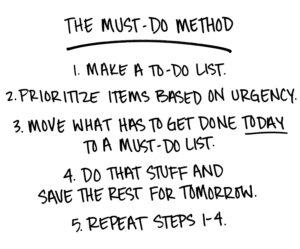This is my seventy-seventh post, and I have to say that after all of the productivity tools I have explored, my favorite remains the Must-Do Method.
I first learned about the Must-Do Method in Sarah Knight’s book Get Your Shit Together, and I loved it so much that I wrote about it way back in post 1.36. It’s one of the tools I teach the most in coaching sessions, so I thought I’d give you a behind-the-scenes view into how I use it on the daily.
What’s the Must-Do Method?
Even though it packs a huge punch, the Must-Do Method is really quite simple. According to Knight herself, the instructions are as follows:

Why It’s Life Changing
On the surface, the Must-Do Method might look like your average to do list, but it’s so much more than that. It taught me how to truly prioritize the things on my to do list by deadline and importance. Whereas a normal to do list just says “do this stuff,” a must-do list asks me to identify what has to be done TODAY, so I can put other things off until tomorrow, or the next day. This is A BIG FLIPPIN’ DEAL for my workaholic tendencies, which often prompt me to do everything and then find more to do so I feel like I’m accomplishing the most. The thing is, there will always be something more that I could do, but the Must-Do Method reminds me that it’s not only okay, but smart and practical to do some things later. This tool helped me learn how to value things like self care and taking breaks, and it taught me how to set boundaries around my output and reevaluate what really matters to me most.
How I Do It
Every Sunday, I find some time to write out all of the things on my docket for the next week. I batch them into the categories I use in my Todoist app: dissertation, healing appointments, work, errands, blog, coaching, mind/body/spirit practice, personal, and professionalization.
Then, next to each one of the things on my list, I write down when I must do that task. Work and appointments are easy, because they are literally already scheduled in my calendar and other people are holding me accountable for being at a place at a time. Some things happen on the same day every week (post blog on Tuesday, dissertation in the mornings 4-5 weekdays a week). For the remaining things, I assign the lower priority tasks and the tasks that take the least amount of time and energy to the days when I have less going on and thus am likely to have time and spoons left to accomplish them. This includes tasks that have some wiggle room in terms of when I do them, like laundry or grocery shopping. So, I’m relying on a combination of routine and rhythm for scheduling my tasks.
My next step is to enter my tasks in my Todoist app (you could use your planner or whatever scheduler you use). This step is helpful because it allows me to visualize the balance of my tasks. If I’ve booked seven things for a Tuesday, I give a hard look at how much time/energy they each take and also at which tasks might be able to roll over to Monday or Wednesday. Similarly, if I have multiple tasks to accomplish, I use the color flag system to mark them as red for high priority, orange for medium, yellow for try to get to it, and no flag for things that would be okay to roll over if needed. I try my damndest to not work on the weekends, so I pay special attention to what tasks I schedule for Friday (for example, will I actually finish this task in one day? Can I do some of it on Thursday to prepare?)
Finally, I check off the tasks as I accomplish them each day. I thrive when I have external accountability, and combining the Must-Do Method with Todoist means I get to visually see my progress taking place. Perhaps my biggest motivator to check off my tasks is to get to the delicious blank Todoist screen that tells me I’ve accomplished my goals for the day. Because I already went through my whole week and scheduled everything, this means I can choose to do other tasks from later in the week and check them off now or I can choose to take the rest of the day off. The Must-Do Method means that option two—taking the day off—is totally okay!

Shifting from a nonstop to do list to the intentional Must-Do Method will take some adjustment. Below, I share how I handled a few hurdles as I made the shift from nonstop output to checking off my must-dos.
Concern: “I’m am not completing all of my tasks each day.”
The main issue might be that you are simply attempting to do too many things with a limited amount of personal resources (specifically time, energy, focus). Look over your list, and ask yourself:
- Is this task too vague? If so, how can I make it more actionable and specific? For example, instead of “write dissertation,” try “write one page of chapter 1.” Be realistic and set yourself up for success.
- What makes it feel like a “must-do” task in the first place?
Concern: “I keep rescheduling the same task for the next day, then the next day…”
If there’s a task you keep avoiding, it might be because you need to try a different approach.
- Is my task aversive? Check out this post on how to handle aversive tasks.
- Do I really need to do it now, or can I reassign it for the future? The second that you decide something is not a must-do, go ahead and reschedule it in your calendar. You can schedule in a power hour a’la Gretch Rubin, where you schedule a predetermined amount of time to do the small tasks you’ve been putting off.
- Is it possible to just not do this thing at all?
- Can I delegate it to someone else or ask someone to help me with this task?
Concern: “I just don’t think I can complete my must-do list today.”
Not every week is the same. Things will come up and require you to shift your must-do priorities (getting sick, chronic illness or pain flare ups, emergencies, being hit with surprise deadlines, to name a few). When you get hit by surprise responsibilities, take a hard look at your must-do list and give yourself permission to shift your perspective to resee self care, personal connection, and health as must-dos themselves. If your upset is less dire, ask yourself:
- Am I burnt out? What is the lowest denominator must-do on my list? Reschedule it.
- Do I need to allow myself extra time to complete a must-do task?
- If there’s a task you think you could complete with support, ask a pal to go with you or sit with you while you finish the task.
Let me know on this week’s Instagram or Facebook post if you are a Must-Do Method fan!
newsletter and free resources
Sign up below to access six free resources and my newsletter, tending.

